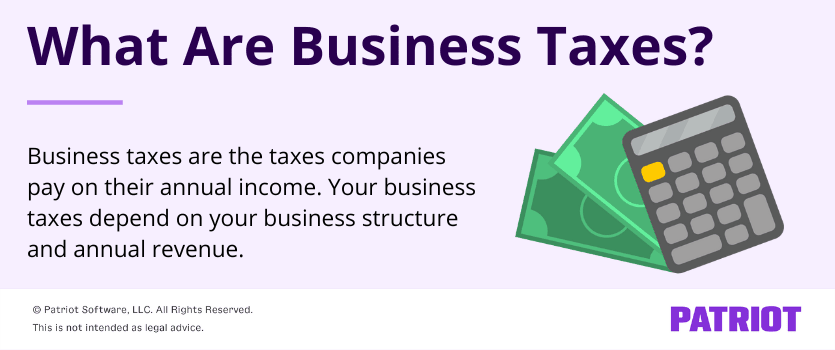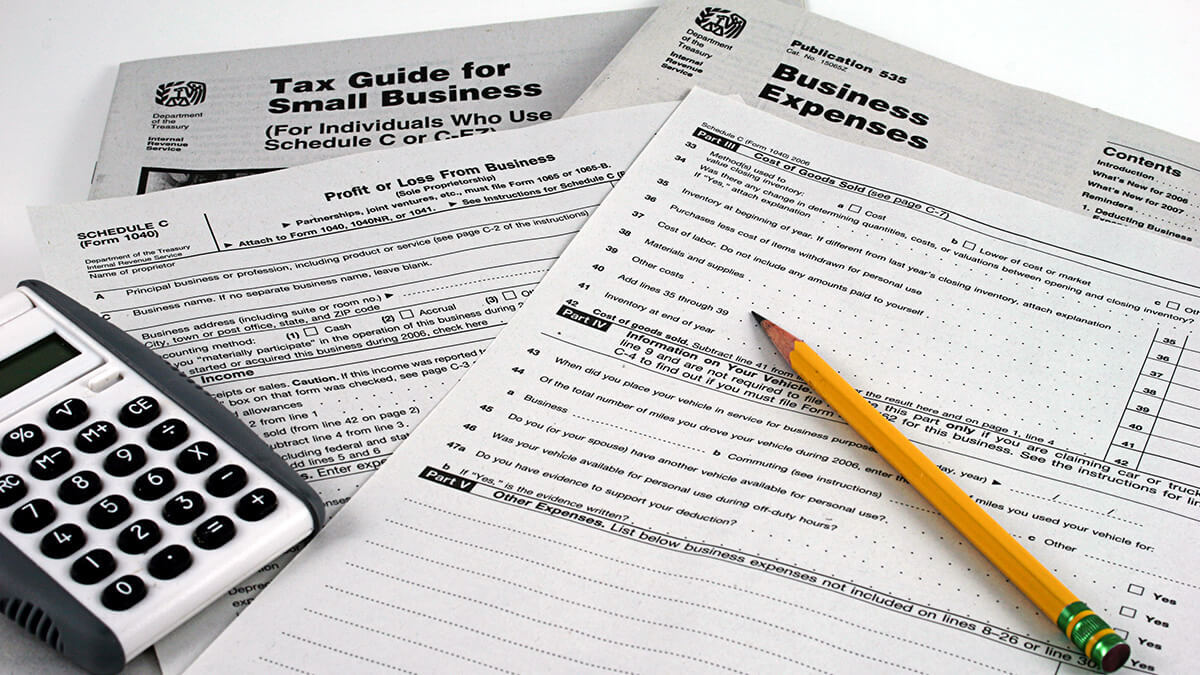Tax season can be hectic, especially if you’re a small business owner. If you hate filing business taxes, you may wonder, “How much can a small business make before paying taxes?” The answer is: It depends. Read on to learn how much a small business can earn before paying income taxes.

What are business taxes?
Business taxes are the taxes companies pay on their annual income. Your business taxes depend on your business structure and how much money you make for the year.
Certain business entities have pass-through taxation, while others don’t. Pass-through businesses include sole proprietorships, partnerships, limited liability companies (LLCs), and S corporations. Close to 95% of businesses are pass-through entities.
With pass-through taxation, a company doesn’t pay income taxes directly. Instead, income taxes pass through to owners, who then pay taxes on business profits on their personal income tax returns.
On the other hand, C corporations are subject to double taxation. A C corporation is a separate tax entity from its owners. This means the company pays a corporate income tax and shareholders pay personal income taxes based on their dividends.
How much can a small business make before paying taxes?
So, how much can a small business make before paying taxes? Again, it depends on the structure of your company and your income for the year. Let’s dive in to see.
C corporations
A C corporation is a separate tax entity from its owners, which means the business has its own tax rates. Corporations are taxed twice, once at the corporate level for revenue generated by the business and another at the shareholder level for the money earned from dividends.
Business taxes on corporate revenue
C corporations always pay a flat 21% on taxable income, regardless of how much or how little the company pulls in.
Let’s say you open a t-shirt business called Tee-rific Threads. In its first year, Tee-rific Threads made $60,000. After expenses and deductions, Tee-rific has $45,000 of taxable income. Because it’s a C corporation and is taxed at a flat rate of 21%, your company pays $9,450 (.21 x 45,000) for its income taxes.
But you aren’t done paying your taxes. Because you’re also a shareholder of Tee-rific Threads, you also have to pay taxes on your shareholder dividends.
Business taxes on shareholder dividends
Shareholders don’t have to log their hours to earn money. Instead, shareholders earn an income because they hold stock in a company. Shareholders must pay taxes on the dividends they earn from their stocks.
First, there are two types of dividends to keep in mind:
- Unqualified dividends: Stock owned for less than 60 days
- Qualified dividends: Stock owned for longer than 60 days
Let’s go back to Tee-rific Threads to see how shareholder dividends are taxed in action.
You aren’t just an owner of Tee-rific Threads; you’re also a shareholder. If you’ve owned your stock for less than 60 days, it’s an unqualified dividend. Use your personal tax rate to pay taxes on unqualified dividends. But if you’ve owned the stock for more than 60 days, it’s a qualified dividend, which the IRS taxes on a sliding scale.
Qualified dividends
Qualified dividends are taxed at the same rate as the capital gains tax. The capital gains tax rate is lower than individual income tax rates.
There are three tax rates for qualified dividends:
Here is what the dividend tax rate looks like for the 2023 tax year.
| Tax Rate | Single | Married, Filing Jointly | Married, Filing Separately | Head of Household |
|---|---|---|---|---|
| 0% | $0 to $44,625 | $0 to $89,250 | $0 to $44,625 | $0 to $59,750 |
| 15% | $44,626 to $492,300 | $89,251 to $553,850 | $44,626 to $276,900 | $59,751 to $523,050 |
| 20% | $492,301 or more | $553,851 or more | $276,901 or more | $523,051 or more |
Remember that dividends that are part of an employee stock ownership plan or issued by a tax-exempt organization aren’t considered qualified dividends.
Unqualified dividends
Unqualified dividends are taxed at the standard federal income tax rate.
The standard federal income rates are:
- 10%
- 12%
- 22%
- 24%
- 32%
- 35%
- 37%
Take a look at the federal income tax brackets for the 2023 tax year.
| Tax Rate | Single Filers | Married, Filing Jointly | Married, Filing Separately | Head of Household |
|---|---|---|---|---|
| 10% | $0 to $10,275 | $0 to $20,550 | $0 to $10,275 | $0 to $14,650 |
| 12% | $10,276 to $41,775 | $20,551 to $83,550 | $10,276 to $41,775 | $14,651 to $55,900 |
| 22% | $41,776 to $89,075 | $83,551 to $178,150 | $41,776 to $89,075 | $55,900 to $89,050 |
| 24% | $89,076 to $179,050 | $178,151 to $340,100 | $89,076 to $170,050 | $89,051 to $170,050 |
| 32% | $170,051 to $215,950 | $340,101 to $431,900 | $170,051 to $215,950 | $170,051 to $215,950 |
| 35% | $215,951 to $539,900 | $431,901 to $647,850 | $215,951 to $323,925 | $215,951 to $539, 900 |
| 37% | $539,901 or more | $647,851 or more | $323,926 or more | $539,901 or more |
Unincorporated businesses
Pass-through taxation means that any business income is added to your personal income. Your filing status and any deductions you claim can change your taxable income and your tax bracket.
With pass-through taxation, your federal income tax bracket and your filing status decide your tax rate. For example, if you’re a single filer with an annual income of $99,000, your tax rate is 24%. So, you’d pay $23,760 (.24 x 99,000). If you’re married and filing jointly with an income of $89,400, your tax rate is 22%, and you’d pay $19,668 (.22 x 89,400) for the year.
Lowering your business taxes
Credits and deductions can help you reduce your business tax bill. You may be able to claim a tax credit or deduction (or both) for qualifying business expenses. If your tax credits and deductions are large enough, you may not have to pay business income taxes.
Remember that you can’t claim a tax credit and a deduction for the same expense.
Pro tip: Tax credits reduce your tax bill, and tax deductions reduce your taxable income.
Business tax credit
Business tax credits are dollar-for-dollar reductions of your tax liability. A tax credit directly lowers your tax bill by the amount of the credit. There are two types of tax credits: refundable and nonrefundable.
A refundable tax credit is paid out in full. So if your tax credit exceeds your tax bill, you get to keep the difference. A nonrefundable credit only covers your tax bill. Any leftover credit disappears once you’ve paid your tax bill.
How do refundable and nonrefundable tax credits work? Let’s look at an example of these types of business tax credits.
Let’s say your business tax bill is $15,000, and you have refundable tax credits totaling $15,500. Once you claim the refundable credit and put it toward your taxes, you can keep the remaining credit of $500. If the credit is nonrefundable, the remaining $500 credit disappears once you apply the credit to your tax bill.
Business tax deduction
A business tax deduction lowers your company’s total taxable income. Remember that both businesses and individuals can claim tax deductions.
For example, imagine your business has a taxable income of $80,000 and claims a deduction of $5,000. The $5,000 deduction reduces your taxable income to $75,000.
When is your business exempt from paying business taxes?
Several situations make a company exempt from paying business taxes. To be exempt from business taxes, your business must have one of the following:
- An annual income below the standard itemized deduction
- Zero taxable income for the year
- A net loss of income
- An income of $400 or less after deductions*
*This only applies to the self-employment tax of unincorporated businesses.
Income below the standard itemized deduction
Businesses with pass-through taxation may not have to pay business tax depending on the company’s annual income because of the standard itemized deduction.
The standard deductions for 2023 are:
- Single and married individuals filing separately: $13,850
- Married and filing jointly: $27,700
- Head of household: $20,800
Zero taxable income for the year
If your company struggles to make money, you may have zero taxable income for the year. What is zero taxable income? Your company can have zero taxable income if it doesn’t generate any annual revenue or if its expenses and income equal the same amount. Without any taxable income, you won’t owe any taxes.
Let’s look at an example. A de-icing business, Olaf and Company, brings in $30,000 during the year, but it also spends $30,000 on new equipment and supplies. Because the income and expenses of the business are equal, the company has zero taxable income and doesn’t owe any taxes. If Olaf and Company didn’t generate any revenue for the year, they’d still have zero taxable income and not owe any taxes.
Net loss of income
If your business suffers a net loss for the year, you won’t have to pay business taxes. What is a net loss? A net loss is when you spend more money than you make.
You can find your net income by subtracting expenses from your gross income.
Gross Income – Expenses = Net Income
Remember, there are two ways to have a net loss of income—your business can either operate at a loss or claim self-employed tax deductions that exceed your income. In either case, you won’t have to pay business taxes as long as your company operates at a loss for the year.
Income of $400 or less after deductions
Generally, self-employed individuals must pay a self-employment tax to make sure they pay their portion of FICA taxes based on their annual income. But, if your net earnings from self-employment were less than $400, you don’t have to file a business tax return.
There’s no reason your small business accounting has to be complicated. Simplify things with Patriot Software’s online accounting software. Patriot offers easy onboarding with a startup wizard, one low monthly price, and free USA-based support. Try it for free today!



